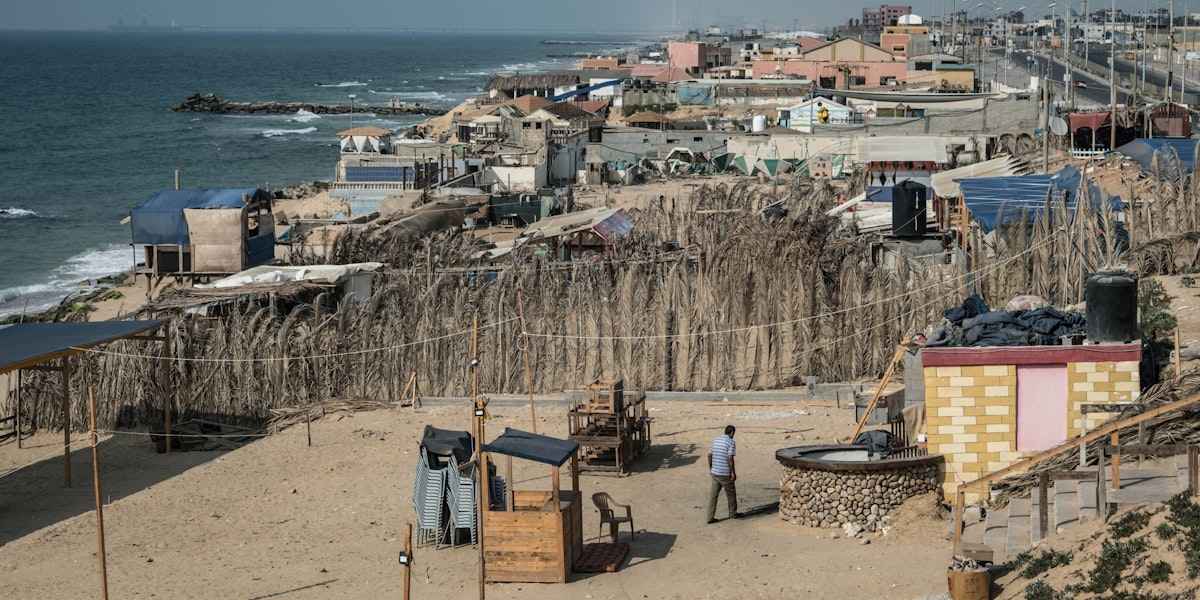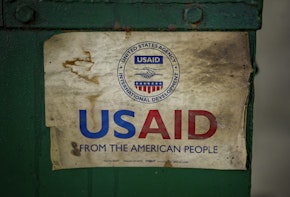The water crisis in Gaza is a problem of daunting proportions, with grave implications for the more than 2 million inhabitants of the besieged Palestinian enclave.1 The narrow 365-square-kilometer strip has no perennial source of surface water, and is completely blockaded by Israel and Egypt on all sides. The aquifer from which it pumps water is diminishing, but more dangerously, it is experiencing significant deterioration from seawater and highly saline groundwater intrusion, as well as pollution. As Gaza runs out of potable water, there is a real likelihood of a large-scale humanitarian disaster that will make the territory’s current tribulations—grave as they already are—much worse.
But the crisis of water in Gaza also holds promise. An effective response can have positive reverberations far beyond the realm of water provision. That’s because Gaza’s water problem will require cooperation between antagonists, to their mutual benefit. There is no solution that can be achieved by Gaza or Israel in isolation; both have an interest in solving the crisis before it further impacts regional environmental and public health.
Addressing Gaza’s need for water can open the door to other forms of cooperation, and in the current political climate, genuine cooperation in the environmental and humanitarian field could enable positive transformation of the conflict. Further, effectively addressing the problem of water in Gaza is directly associated with a universally acknowledged vital human need, more so than any other area of dispute between Israel and the Palestinians. As such, it holds more possibility as an area in which to collaborate.
This is not to say that solving the worsening water crisis in Gaza will be easy. All the problems in Gaza are intertwined with others. A solution will require delicacy, a complete understanding of the controversies surrounding water, and the assertive and fair involvement of the international community.
There is, however, a simple way to start. The United States and the international community should support the importation of bulk water from Israel through a multi-year arrangement. This action would offer a combination of environmental, water, and human security benefits that would decrease political tensions between Palestinians and Israelis. The initiative would further allow UN institutions and donors valuable time to support the implementation of the ongoing Palestinian strategy to respond to the water crisis—the 2011 Gaza Program of Interventions (PoI)—in conjunction with a broader program of reform of the water sector.2
Both Israel and the Palestinians will need to embrace at least limited cooperation for the greater good.
This report recalls the origins of Gaza’s water and environmental disaster. It critically reviews assessments by the international community that have sought to address Gaza’s water crisis (such as the World Bank’s 2009 “Assessment of Restrictions on Palestinian Water Sector Development”), as well as the integrated PoI, as the basis of the Palestinian response.3 Selected from a broader menu of options, the Palestinian Water Authority (PWA) set aside a number of recommended interventions due to political impediments, including the blockade of Gaza by Israel and Egypt since 2007. Importantly, Palestinian officials have always emphasized that the PoI could only successfully mitigate the water crisis if the enabling environment to humanitarian and development efforts—such as availability of essential materials and sustainable electrical supply—was meaningfully improved. Thus, while Israeli provision of water to Gaza would undeniably benefit both parties, it will also require Israel to relax at least one aspect of its blockade. Both Israel and the Palestinians will need to embrace at least limited cooperation for the greater good.
A Worsening International Disaster
Decades of overpumping groundwater have caused Gaza’s underlying aquifer to deteriorate. This overpumping has resulted in a correspondingly dramatic impact on the ecosystem, economic livelihoods, and human health of more than 2 million inhabitants of Gaza. Only 5 percent of the available water resources in the territory are fit for human consumption. And this figure actually understates the problem: that 5 percent includes the small volumes of fresh water that Israel sells and transfers. Without Israel’s sale and transfer of this water, only 2 percent of water sources in Gaza would be fit for human consumption.
A lack of progress in water and sanitation investments has compounded the impact of groundwater deterioration on the public health of Gaza. Both salinity and nitrate levels in the groundwater have been well above World Health Organization (WHO) guidelines for safe drinking water.4 A 2018 report from the RAND Corporation, “The Public Health Impacts of Gaza’s Water Crisis: Analysis and Policy Options,” studied water-related risks in Gaza, and noted that poor water quality and lack of access to water contributed to more than a quarter of all reported diseases in the strip.5 More than 50 percent of Gaza’s children suffer from water-related parasitic infections and chronic diarrhea, which affect child growth and development.6 A recent health risk assessment found that nitrate levels in Gaza exceed the WHO limit in 91 percent of municipal wells (223 of 245 wells), and that nitrate levels are unacceptable for children and infants’ drinking purposes in all wells.7 Nitrate contamination is linked to “blue baby syndrome” (also known as cyanosis), affects pregnant women, and may increase the risk of certain types of cancer. Moreover, adults and children are at risk of a range of water-related diseases, since drinking saline water can cause kidney dysfunction, heart failure, neurological symptoms, lethargy, and high blood pressure. The water, sanitation, and hygiene crisis renders Gaza’s inhabitants acutely vulnerable to the outbreak of disease—waterborne or otherwise.8
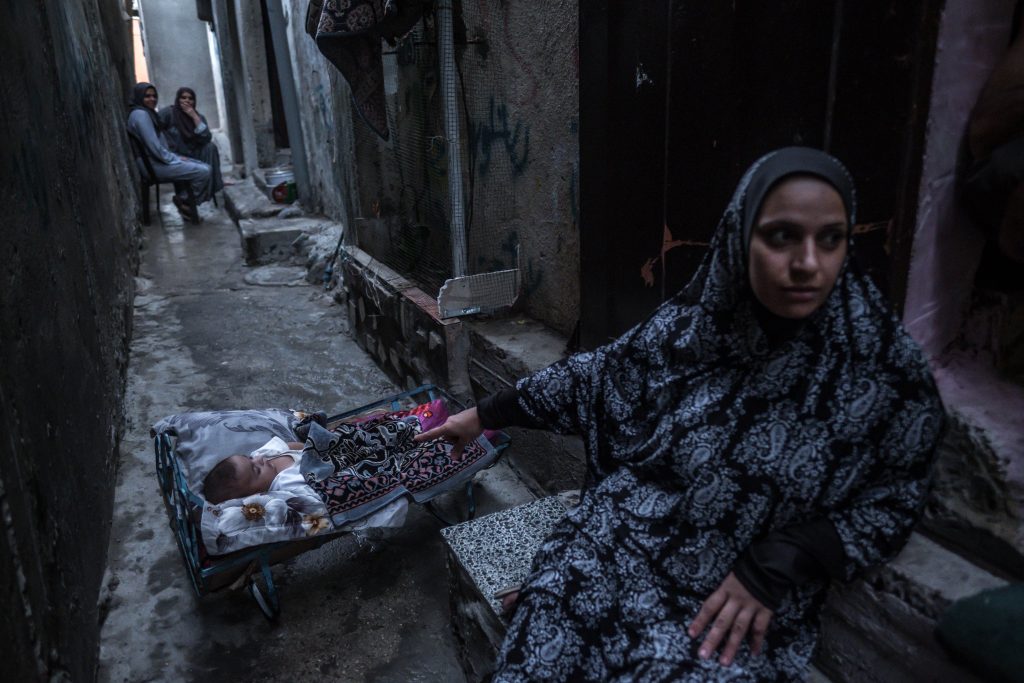
The health impacts of Gaza’s water crisis will not be contained within its borders. The RAND report highlighted that the combination of poor water supply, limited hygiene practices, and insufficient sewage treatment in Gaza could lead to a disease outbreak that spreads outside of the territory. Israel, too, has recognized this danger. The Israeli state comptroller has identified water pollution as Israel’s most serious cross-border environmental hazard, highlighting that such widespread pollution not only degrades the groundwater quality of Israel and its neighbors, but also harms public health and the quality of life.9
In a recent example of the perniciousness of such transboundary problems, at press time COVID-19 was on the verge of “overwhelming” Gaza’s hospitals. A major outbreak there will surely have repercussions in Israel.10 The pandemic is a stark illustration of the impossibility of segregating Gaza’s health outcomes from those of the region, let alone those of Israel.
The world has come together in universal political commitment to the Sustainable Development Goals—the seventeen targets that the UN has set for global achievement by 2030. But the goals of sustainable development for the inhabitants of Gaza are simply unattainable absent the broad application of international law. Without the removal of the existing blockade, Palestinians will almost certainly fail to implement the Gaza PoI that is meant to stabilize the water crisis. Palestinians and the international community have attempted a variety of measures for years—and are often compelled to advance suboptimal interventions—to address the worsening water and ecological situation in Gaza. But all responses are inescapably framed by the normalization of the initial displacement of several hundred thousand Palestinians to Gaza in 1947–49, the geographical diminution of Gaza, and the Israeli military’s control over inhabitants, which has increased since 1967.
While solutions to Gaza’s plight may be out of reach without larger political and legal remedies, it is still possible to significantly mitigate the water crisis. The international community can work to stabilize the worsening environmental and health impacts.
But while solutions to Gaza’s plight may be out of reach without larger political and legal remedies, it is still possible to significantly mitigate the water crisis. The international community can work to stabilize the worsening environmental and health impacts. And preventing matters from deteriorating further can provide a foundation for more substantial improvements down the road.
An Artificial Shortage of Water
In ancient times, Gaza was known for the quality of its groundwater, which afforded sustenance and livelihoods to its inhabitants. Water resources provided a high quality of life for the inhabitants until the 1947–49 conflict that erupted around the founding of Israel. In the 1940s, less than a decade before the end of the British Mandate period in Palestine, the district known as Gaza comprised an area of land some three times larger than today’s enclave, but held a population of only 151,000, for a population density of just 137 people per square kilometer.11 At the time, the inhabitants of Gaza used 27 million cubic meters per year (mcm/y) of groundwater. As we search for an effective response to Gaza’s water crisis, it is important to understand how Gaza—once admired for its plentiful water—became so crowded, and its groundwater so overdrawn.
In 1947–49, some 200,000 Palestinians from 247 villages in southern Palestine (territory that is now Israel) were displaced to Gaza.12 Palestinians refer to these events—and the displacement of hundreds of thousands of other Palestinians out of their ancestral lands—as the “Nakba,” or the Catastrophe. While Israel contests the history of these events, for Palestinians, there is no doubt that this displacement was forced. The Nakba might be compared to the nineteenth-century Trail of Tears in the United States, in which the government transferred Native Americans from their historic lands in the southeast to Oklahoma (then known as the Indian Territories).13 For Palestinians, the newly established Israel was advancing a twentieth-century version of Manifest Destiny.
Then, Gaza began to shrink. The February 1949 Egyptian–Israeli Armistice Agreement reduced the size of Gaza’s territory by half.14 In 1950, a secretly negotiated amendment to the agreement reduced the territory by another 17 percent compared to its prewar size.15 The diminished enclave then had only sixty-two wells providing 2 mcm/y of water—about 7.5 percent of British Mandate Gaza’s prewar water supply, for a smaller area whose population was suddenly three and half times as big.16 From the outset, the Gaza Strip was compelled on a downward path of unsustainability.
Today, Gaza has more than 5,600 inhabitants per square kilometer—one of the most densely populated polities in the world. The enclave, with a territory now slightly larger than double the size of Washington, D.C., today has access to 101 mcm/y for domestic supply.17 The section of land that today’s Gaza Strip comprises has a population that has increased more than twenty-five times—and water sources that have not.18 It is thus little wonder that today, Gaza’s water resources are under extreme stress.
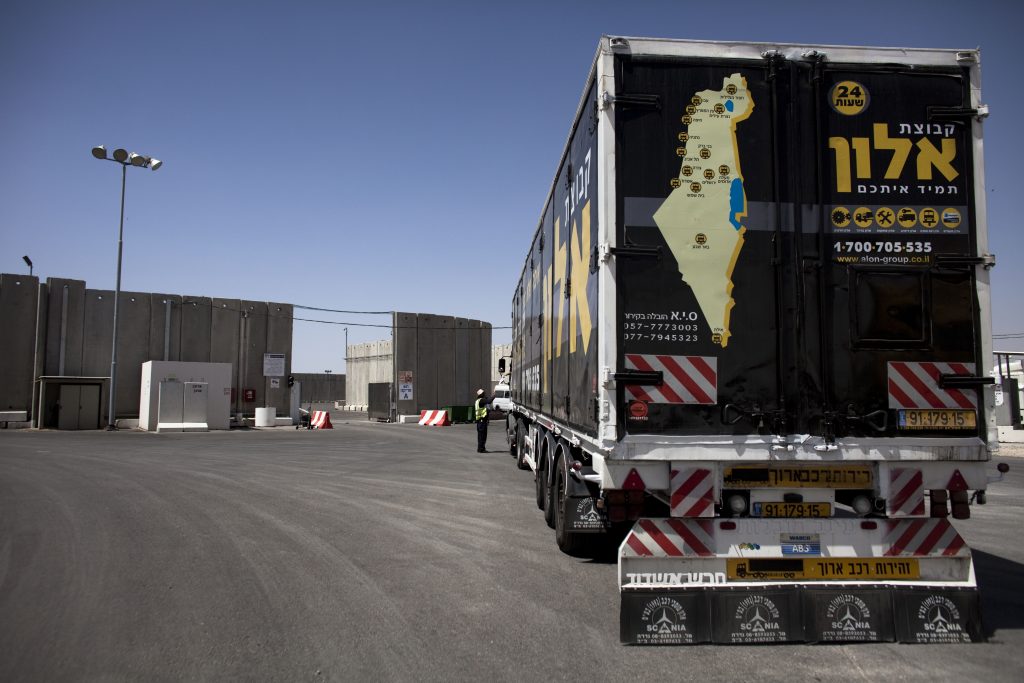
Throughout the world, large urban environments are not water resource self-sufficient, but rather depend on the transfer of water supply from hinterlands or remote areas. But being under siege and completely isolated, Gaza has no hinterland, and is in a singularly desperate situation when it comes to water.
The inhabitants of Gaza are almost completely dependent on the underlying groundwater from the Coastal Aquifer as their principal water resource. Running from Mount Carmel in northern Israel to the Sinai in Egypt, the Coastal Aquifer is a classic transboundary aquifer whose management is addressed by customary international water law. The primary substantive principle of such law is “equitable and reasonable utilization,” which emphasizes the primacy of “vital human needs” in the management of the resource.19 Despite having other natural water resources, Israel has consistently drawn 75 percent of the sustainable groundwater amount each year from the Coastal Aquifer, which almost certainly exceeds its fair share under international water law. With no alternative water resource, an overpopulated Gaza pumps beyond the sustainable groundwater amount each year. Highly saline inflows, including seawater from the Mediterranean, rush in through porous geological formations to fill what hydrogeologists call a “depression.”
Gaza’s ecological disaster happened not only under Israel’s watch—but also because of Israel’s five decades-plus of occupation and control. And understanding this fact is important for creating an effective remedy.
The history makes it clear that Gaza’s ecological disaster happened not only under Israel’s watch—but also because of Israel’s five decades-plus of occupation and control. And understanding this fact is important for creating an effective remedy.
Foreign Administration and International Assistance
Gaza’s man-made water crisis is only partly the result of an ever-growing population forced into a shrunken patch of land. The development and water use policies of neighboring states—especially Israel—have significantly contributed to the disaster. From 1949 to 1967, Egypt administered Gaza and drilled agricultural wells to ensure food security and support Gaza’s economy with food exports. But within weeks of the Israeli occupation of Gaza following the 1967 Arab–Israeli war, Israel issued military orders specifically related to controlling Palestinian water resources, including requiring that any Palestinian development of water resources receive authorization by the Israeli army.
Meanwhile, Israel extracted heavily from the Coastal Aquifer, which runs continuously under both Gaza and Israel—and, of course, is a natural feature that doesn’t observe borders.20 Withdrawing water for use in Israel depletes the water available in Gaza. Some Israeli wells have even been drilled within Gaza. For example, Israel developed a series of wells within Gaza extracting 5–8 mcm/y to irrigate crops cultivated in its settlements there (Israel dismantled those settlements in Gaza in 2005). These extractions represented about 6 percent of Gaza’s water use at the time.21
In the wake of the Oslo Accords, from the late 1990s into the twenty-first century, the international community made various attempts to bring some relief to the water situation. None saw great success, but a theme emerged: there was a deepening crisis. Established in December 1995 immediately after Oslo II, the PWA estimated the sustainable yield of the aquifer under Gaza to be 50–60 mcm/y, but the water demand of Gaza’s inhabitants had already compelled pumping of groundwater well above this threshold. The international community, led by the United States, engaged in significant assistance to the Palestinian water sector.22 A 1997 World Bank–organized meeting in Gaza described the overpumping, seawater intrusion, and pollution in the aquifer as an “emergency state of affairs,” and stated that under normal circumstances pumping would have to stop immediately.23 Recognizing the environmental damage caused by overpumping of groundwater, the United States Agency for International Development (USAID) funded the Integrated Coastal Aquifer Management Plan, released in May 2000, and launched a program to construct a large-scale desalination plant to provide fresh water and to alleviate overpumping. But the U.S. government halted this potentially game-changing intervention in 2003.
The recommendations to stop pumping water were earnest, but unrealistic. Gazans’ use of water—some eighty-five liters per person per day of poor-quality—is already just one-thirteenth of what the average American consumes.
The recommendations to stop pumping water were earnest, but unrealistic for the people in Gaza to abide by. Their use of water—some eighty-five liters per person per day of poor-quality—is consistently well below WHO minimum guidelines of one hundred liters per person per day of good quality water for all domestic uses.24 (By comparison, the average American domestically consumes more than thirteen times as much water per day as a person in Gaza.)25 Agriculture accounts for a little more water use than domestic purposes in Gaza (though for less than agriculture does in most of the Middle East). This makes sense, since water is an essential input for agriculture, which provides food security and maintains livelihoods.
What Gaza has always required is alternative water resources, but the political context has consistently inhibited its water sector development. In 2009, the World Bank lauded Gaza’s master plan for water and sanitation—the Integrated Coastal Aquifer Management Plan—which calls for a number of interventions needed for the water supply, and for improving water quality and sanitation services. It also describes the governance and capacity-building needs related to the sector.26 But by the time of the World Bank assessment, only 2 percent of Gaza’s investment plan had been implemented. “It has proved impossible to implement the Plan under emergency closure conditions,” the Bank wrote. “Fundamental change in the political and security situation is needed to create an environment for renewed investment.”27
Thwarted by Instability and Conflict
The Gaza blockade began in 2007, and was followed in 2008 by Operation Cast Lead, one of numerous Israeli military campaigns against Gaza. In this deteriorating political context, the PWA limited the proposals it considered for certain options for water supply, because it assessed them as being too challenging—even as it faced a worsening water situation. Among the options it excluded for this reason was the large-scale transfer of water from Israel.28 The PWA hoped that the future would permit additional interventions.
In mobilizing the international community to support the PoI (the 2011 Gaza Program of Interventions), Palestinians highlighted that success depended on overcoming delays (or denials) by Israel of imported materials, the unreliable supply of electricity essential to implement and operate interventions, and an economy crippled by the blockade, which impaired inhabitants’ ability to pay for water and sanitation services. The PoI included nine interventions that were supposed to be advanced in a coordinated and integrated approach, with the highest long-term priority attributed to a proposed large-scale desalination facility, which was recommended to have an initial output of 55 mcm/y, expanding to 110 mcm/y by the mid 2020s.
Initially, a six-year timeline was proposed in the PoI to accelerate interventions that had been identified. These interventions included wastewater treatment plants in the governorates of North Gaza and Khan Younis, and in central Gaza. The PoI also called for technical feasibility studies and the implementation of many short- and medium-term interventions, such as a Gaza program coordination unit and the short-term, low-volume desalination facilities at Deir al-Balah, Khan Younis, and North Gaza. However, as of fall 2020, the overall PoI has achieved limited progress against its original timelines, due in large part to pervasive delays of materials by Israel, power deficits, Gaza’s dependence on international assistance, and military conflict.
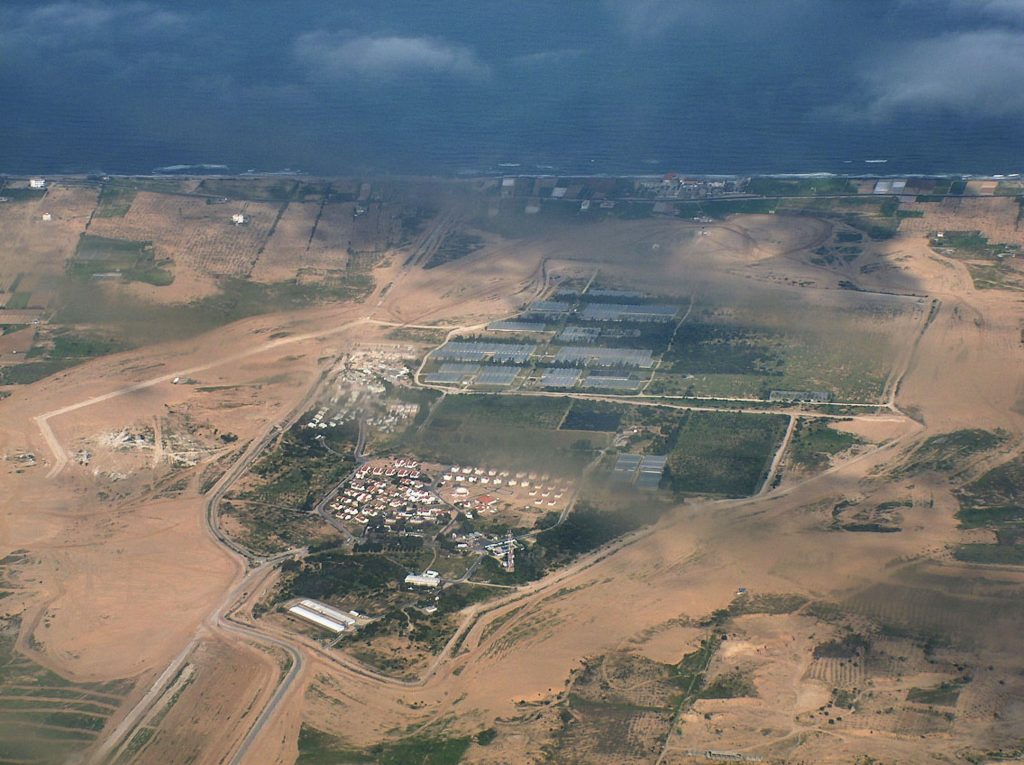
Precious time has been lost as donors have, understandably, been reluctant to commit funding to multimillion-dollar infrastructure projects over concerns that Israel might target and destroy infrastructure. That is what happened in 2014, when during another round of fighting, Israel partially destroyed the Gaza Power Plant—the territory’s only power plant. Initially, the attack rendered the plant inoperable; it later regained only part of its generating capacity. This loss had devastating collateral effects, since the water and sanitation infrastructures also depend on electricity.29 Palestinians and the international community have spent years requesting Israel’s cooperation in increasing the importation of fuel used to generate power in Gaza, expanding the electrical supply conveyed from Israel and Egypt to Gaza, or developing renewable energy projects. They have attempted to implement numerous interventions that would decrease dependence on the electrical grid, but that would also increase capital costs and depend on the importation of essential materials, which is also difficult because of the blockade. Israeli security has identified many basic construction materials as “dual use”—having a possible military application—and thus subjecting them to elaborate procedural requirements. Such “dual use” designations are just one in a range of pressure points that Israel has used to impede the upgrade of existing water networks and the construction of new water lines, technologically sophisticated small desalination units, and wastewater treatment plants.
Revisiting Bulk Water Imports from Israel
In the prevailing context, “solutions” to Gaza’s water and environmental catastrophe are unattainable, despite how vital they are for well-being. Even if the current disaster is mitigated, Palestinians will continue to advocate for their water rights, and for the application of international law—including as it applies to Israel’s responsibility to use an equitable and reasonable amount of water from the Coastal Aquifer and other shared water resources. But the significant decline in human health and livelihoods resulting from the deterioration in availability and quality of fresh water demands additional humanitarian action. Palestinians and the international community should revisit the bulk importation of water supply from Israel, as a humanitarian initiative that could dramatically improve the health situation in Gaza. The transfer of large volumes of fresh water from Israel would significantly alleviate the need to overpump groundwater, which is essential to address the failing aquifer. Transferring water from Israel would also sidestep some of the challenges of securing necessary materials and electricity.30
The PoI did include in its recommendations increasing water imports from Israel, albeit in small volumes. But Palestinians were not able to secure Israeli engagement on this intervention until the aftermath of Operation Protective Edge of 2014—another Israeli military action that prompted a humanitarian outcry from the international community. In March 2015, Israel’s Coordinator of Government Activities in the Territories (a body within the Ministry of Defense) announced that an additional 5 mcm/y of water would be supplied to Gaza above the existing 5 mcm/y.31 Still, it took several years just to repair destroyed infrastructure in Gaza before the full amount could be delivered. In 2019, Gaza received 11 mcm of water from Israel’s national water company, Mekerot. Water conveyance and supply systems are under development to accommodate an additional 20 mcm/y in the future, but larger quantities could be available sooner should the bulk importation approach be prioritized. Increasing the high-quality water supply would profoundly boost the human and environmental health of Gaza and save lives, especially those of the most vulnerable and at-risk children.
The Israeli water industry is fully capable of providing the additional water. In 2014, the Israeli daily Haaretz reported that “there is now a surplus of water in Israel, thanks largely to the opening of several new desalination plants—and the development of natural-gas fields that can power them cheaply. . . . Today, Israel has so much affordable water, it can offer to export it.”32 Indeed, Israel is already exporting water to Palestinians in the West Bank. Mekerot sold 76 mcm to the West Bank in 2019—seven times more than the water transferred to Gaza. (The West Bank’s population is about one-and-a-half times Gaza’s.) Importantly, the production of the additional water supply would all occur in Israel, where there are no concerns about shortages of power or access to essential materials.
The PoI emphasized the construction of Gaza’s first major desalination plant as the highest priority. For the reasons described above, there have been significant delays to securing international financial commitments and technical planning from the original PoI timeline (itself a delay of the 2003 USAID project), not to mention the difficulties caused by the blockade and poor energy supply. But Israel can make up the vital shortfall by supplying Gaza with an additional 55 mcm/y of water—more than half of Gaza’s currently available domestic amounts. In fact, importing water from Israel in that volume could actually be accomplished much more quickly, at this point, than the construction of a new facility—especially considering the near-certain impediments to construction in Gaza. Of course, the Palestinian enclave must continue to develop the desalination plant, since even the combination of the desalination plant and the water importation scheme above would fall short of Gaza’s total need for fresh water. But the importation would provide a critical stopgap.
To be effective, bulk water importation needs robust financing and good planning. Israeli planners and investors would require a multi-year arrangement.
To be effective, bulk water importation needs robust financing and good planning. Israeli planners and investors would require a multi-year arrangement, which in turn would likely require complimentary commercial agreements with Israeli operators in the private sector. An initial arrangement for, say, twenty years would ensure sufficient time for the implementation of the PoI, with the continuing assistance of the international community. Gazans could feel more confident about their water, which would be cleaner and cheaper than the water they currently purchase from private vendors in Gaza for drinking and cooking.
The Role of the United States
The United States should use its political and economic influence to orchestrate a regional humanitarian win by securing bulk water importation from Israel. Under the banner of water security, the United States can lead the international community to a targeted, regional achievement on water supply, which also protects a key shared natural resource and safeguards the public health of its allies Israel and Egypt.
Since the launch of the United States’ Global Water Strategy in 2017, several strategic objectives guide its engagement on international water issues. The United States has recognized that, around the world, growing water crises can increase disease, undermine economic growth, and foster insecurity and state failure. In response, Washington has declared that it “will focus its efforts on countries and regions where needs and opportunities are greatest and where engagement can best protect national security interests.”33 Gaza and the West Bank comprised one of thirteen beneficiaries that the United States initially identified as “high priority” under the strategy, with the amount of money budgeted to them second only to Jordan.
Yet despite this policy, in August 2018, the administration of Donald Trump cut $200 million in bilateral aid designated for humanitarian programs in the West Bank and Gaza, and a week later cut $300 million in funding intended for the United Nations Relief and Works Agency for Palestine Refugees (UNRWA). Both cuts took funds from activities addressing the water and sanitation crisis in Gaza.34 Then, in 2019, all U.S. aid to the West Bank and Gaza was stopped, though subsequent congressional initiatives have sought to advance funding to support humanitarian assistance for Palestinians.35 There is no doubt that the humanitarian needs of Gaza’s inhabitants are pressing enough to merit the application of the Global Water Strategy, which states that the United States will “increase access to safe drinking water, sanitation, and hygiene for the underserved and most vulnerable.”36 While it is as yet unknown how the administration of the president-elect, Joe Biden, will continue using this strategy, it seems reasonable to assume that it would embrace similar principles.
Addressing the water crisis can also enhance U.S. national security interests. Accustomed to reaching multi-year arrangements with Israel, the United States last year began providing security aid to Israel under its third ten-year memorandum of understanding. The arrangement encompasses $3.8 billion of funding per year in security assistance to Israel, of which a quarter is currently permitted to be used to purchase items from Israel in accordance with the “off-shore procurement allowance”—an amount that Israel is allowed to spend on Israeli-manufactured equipment.37 A reinterpretation of the off-shore procurement allowance amending the existing Israeli–American agreement could lend itself to purchases from Israel’s water industry, as the United States continues to place increased significance on environmental and water security, especially in the Middle East.
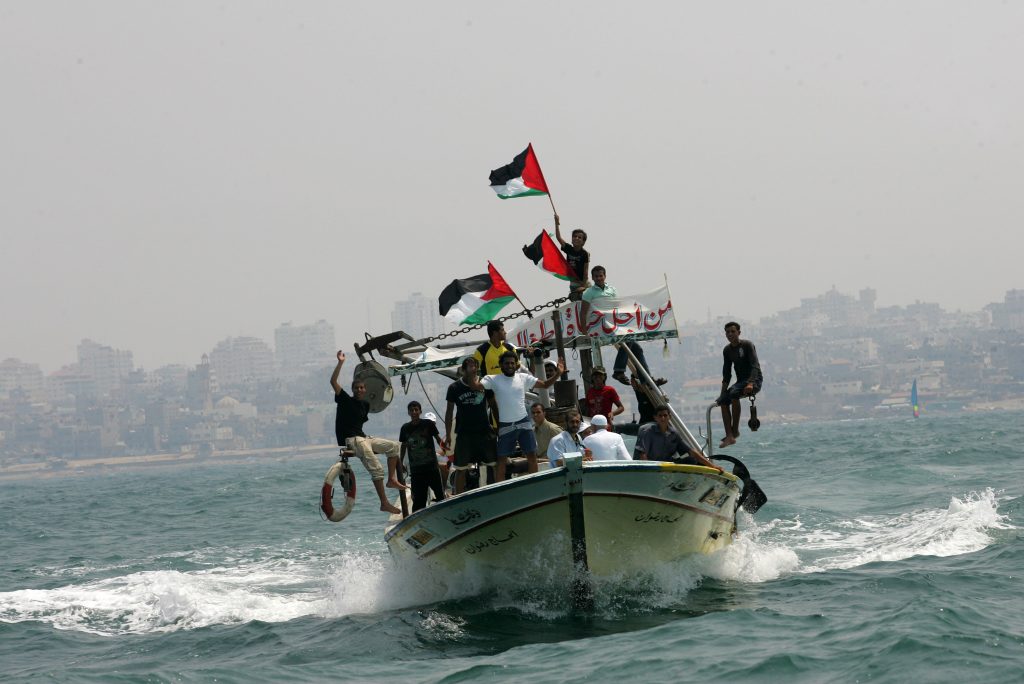
A 2017 Israeli–Palestinian water pricing arrangement, facilitated by U.S. diplomats, set the price for water sold from Israel to Gaza at 3.2 shekels (a little less than a dollar) per cubic meter. At this price, 55 mcm/y of bulk water imported from Israel would cost approximately $51.7 million per year. This amount is significantly less than the cost of one F-35 fighter plane. It would also arguably be an investment with a triple bottom-line return, improving the environmental and public health security of Israel and Egypt, as well as that of Palestinians in Gaza. By directing approximately 1.4 percent of the American aid’s annual financial benefit to the Israeli water industry, Israeli enterprises would continue to benefit from U.S. security assistance. And from the perspective of improving management of the Palestinian water sector, there would be additional value in the U.S.-led international community leveraging the purchase of the 55 mcm/y of water from Israel: it could condition Palestinians to improve billing and increase municipal revenue collection from water services. This, in turn, would slowly decrease the size of financial support necessary for the international community’s subsidization of water supply to Gaza in future years.38
A Water Win-Win
As a humanitarian undertaking, the importation of water to Gaza would almost certainly serve as a significant factor to increase human and environmental health for the inhabitants of the strip. It would also enhance U.S. national security interests by significantly addressing a source of tension. Further, importing water would sidestep the persistent difficulty—largely the result of the blockade, the lack of electricity, and onerous Israeli restrictions on construction materials—of developing Gaza’s water infrastructure. Bulk water supply to Gaza would also benefit Israel, by alleviating the overpumping of the Coastal Aquifer.
There is precedence for cooperation over water even when countries are at war—it has occurred between India and Pakistan, for example. Even the bleak prospects of an Israeli–Palestinian peace should not discourage hopeful engagement to reduce tensions and conflict in areas of common interest and mutual benefit. Broader issues do not go away; but, in providing for the human security of the people of Gaza, the initiative lowers the temperature between Gaza’s inhabitants and Israel, creating space for the parties to seek solutions. In short, importing water would be a significant investment in stability between Gaza’s inhabitants and Israel.
“The satisfaction of a population’s basic water needs mitigates the risk of political instability and water-related conflicts,” World Bank attorney Christina Leb has written. “International water law addresses this causal relationship by putting increasing emphasis on the necessity to respect vital human water needs in the management of transboundary water resources.”39 We would do well to heed this simple logic. Because though we can only speculate whether importing water to Gaza would increase long-term security, it is certain to decrease frustration and desperation—developments that everyone in the region should be able to embrace.
This report was written with support from the Rockefeller Brothers Fund as part of the TCF initiative “Nature and National Security in the Middle East.”
header photo: A man in Gaza leaves after closing his cafe on the corniche, on August 30, 2020 in Gaza City, as the coronavirus lockdown begins. Source: Fatima Shbair/Getty Images
Notes
- “Estimated Population in Palestine Mid-Year by Governorate,1997–2021,” Palestinian Central Bureau of Statistics, http://www.pcbs.gov.ps/Portals/_Rainbow/Documents/المحافظات%20انجليزي%2097-2017.html.
- “(RPI) Semi-Annual Progress Report January–June 2019: The Rolling Program of Interventions for Additional Supply of Water for Gaza Strip (RPI),” Palestinian Water Authority, June 2019 http://www.lacs.ps/documentsShow.aspx?ATT_ID=43642. See also “The Gaza Emergency Technical Assistance Programme (Getap) on Water Supply to the Gaza Strip,” Palestinian National Authority, July 31, 2011, https://www.humanitarianresponse.info/sites/www.humanitarianresponse.info/files/documents/files/PWA%20-%20CSO-G%20updated%20Final.pdf.
The Gaza PoI can be summarized as follows: (1) Establish a program coordination unit; (2) a water and health monitoring project; (3) upgrading of domestic water distribution and supply network; (4) increased water imports from Israel, in relatively small volumes; (5) short-term low-volume desalination to provide quality water for domestic use in the early years; (6) higher levels of seawater desalination through two regional facilities acting as a key driver to reduce overextraction of groundwater, and critical to long-term protection of human health in Gaza; (7) extension of pilot schemes for treated wastewater use, substituting pumped groundwater; (8) completion of three major wastewater treatment plants, introducing reuse; and (9) a review of water use in the agricultural sector focused on reducing overall demand, introducing wastewater reuse, and optimizing economic returns. - Throughout the report, the authors use the phrase “water crisis” to refer to both the water supply and the wastewater situations that have led to a resulting environmental and health disaster.
- “Gaza in 2020: A Liveable Place?,” United Nations Relief and Works Agency for Palestine Refugees (UNRWA), 2012, http://www.unrwa.org/userfiles/file/publications/gaza/Gaza%20in%202020.pdf.
- Shira Efron et al., “The Public Health Impacts of Gaza’s Water Crisis: Analysis and Policy Options,” RAND Corporation, 2018, https://www.rand.org/pubs/research_reports/RR2515.html.
- “Protecting Children from Unsafe Water in Gaza: Strategy, Action Plan and Project Resources,” United Nations Children’s Fund (UNICEF), 2011, https://www.unicef.org/oPt/FINAL_Summary_Protecting_Children_from_unsafe_Water_in_Gaza_4_March_2011.pdf.
- Luay Qrenawi and Reem Abu Shomar, “Health Risk Assessment of Groundwater Contamination Case Study: Gaza Strip,” Journal of Engineering Research and Technology 7, no. 1 (2020): 10–22, https://journal.iugaza.edu.ps/index.php/JERT/article/view/7899/3129.
- Somdeep Sen, “The Pandemic under Siege: A View from the Gaza Strip,” World Development 135 (2020), https://doi.org/10.1016/j.worlddev.2020.105063.
- Sharon Udasin, “Cross-Border Water Pollution Threatens Israeli Security, Watchdog Says,” Jerusalem Post, May 16, 2017, https://www.jpost.com/Business-and-Innovation/Environment/Cross-border-water-pollution-threatens-Israeli-security-watchdog-says-490928.
- “COVID: Gaza Health System ‘Days from Being Overwhelmed,’” BBC News, November 22, 2020, https://www.bbc.com/news/world-middle-east-55035955.
- These population figures come from a 1940 British census. Gaza was 1,100 square kilometers at the time. See Clemens Messerschmid, “Water in Gaza: Problems and Prospects,” Birzeit University Working Paper no. 19, 2011, http://dx.doi.org/10.2139/ssrn.1764252.
- Salman Abu Sitta, Atlas of Palestine, 1917-1966 (London: Palestine Land Society, 2010), 113–15, https://www.plands.org/en/maps-atlases/atlases/the-atlas-of-palestine/pdfs/atlas-part-1.pdf. See also Abu Sitta, “Gaza Strip: The Lessons of History,” in Gaza as Metaphor, ed. Helga Tawil and Dina Matar (London: Hurst, 2016), https://www.plands.org/en/articles-speeches/articles/2016/gaza-strip-the-lessons-of-history.
- Caitlin Fitz, “The People Who Profited off the Trail of Tears,” The Atlantic, ay 2020, https://www.theatlantic.com/magazine/archive/2020/05/claudio-sant-unworthy-republic-trail-of-tears/609097/.
- With the Armistice Agreement, Gaza was reduced from 1,100 square kilometers to 550 square kilometers.
- The current boundaries do not conform to the 1949 armistice line presented to the UN, which are commonly referred to as the “Green Line.”
- Clemens Messerschmid, “Bitter Water: Prospects for Gaza,” This Week in Palestine, June 2016, http://thisweekinpalestine.com/wp-content/uploads/2014/07/Bitter-Water-Prospects-for-Gaza.pdf.
- The water quantities should not be considered the actual demand, since both aquifer pumping and the generation of nonconventional water amounts inside Gaza are constrained by limitations on the availability of electrical supply. See the “Annual Report 2019” of the Coastal Municipalities Water Utility (published in 2020), pages 14–15, http://www.cmwu.ps/Report/9a26e213-62c9-45de-b256-3b629290ba0c.pdf. The pumping of groundwater for agricultural purposes has consistently been equivalent to water supply for domestic use, which also includes industrial use. For example, agricultural water in 2017 accounted for 96.9 mcm, compared to 96.3 mcm for domestic. “Statistical Yearbook of Palestine,” Palestine Central Bureau of Statistics, 2019, 149, http://pcbs.gov.ps/Downloads/book2495.pdf.
- As noted above, British Mandate Gaza had a population of 151,000, whereas the estimated native population of the current area of Gaza (the Gaza Strip) in the 1940s was approximately 80,000. See Abu Sitta, “Gaza Strip: The Lessons of History.”
- The equitable and reasonable utilization standard provides for the weighing of different kinds of utilization and associated factors of a transboundary aquifer. “In determining ‘vital human needs,’ special attention is to be paid to providing sufficient water to sustain human life, including both drinking water and water required for production of food in order to prevent starvation.” From “Report of UN Sixth Committee Convening as the Working Group of the Whole,” Convention on the Law of the Non-Navigational Uses of International Watercourses, United Nations, A/51/869, April 11, 1997, paragraph 8, https://www.un.org/law/cod/watere.htm. See also Salman M. A. Salman, “Downstream Riparians Can Also Harm Upstream Riparians: The Concept of Foreclosure of Uses,” Water International 35, no. 4, ( 2010): 355, http://www.salmanmasalman.org/wp-content/uploads/2012/12/ForeclosureOfFutureUsesArticlePublished.pdf.
- Zafrir Rifat, “Israel Launches Program to Save Coastal Aquifer,” Haaretz, July 31, 2009, https://www.haaretz.com/1.5084589.
- Following the Oslo Accords, Gaza’s water sector experienced an increase in activity—and misleading optimism—with regard to its development, arising from the perception that Palestinian leaders ostensibly had negotiated Israeli withdrawal from Gaza. Settlements remained until 2005, when the government of Israel under Ariel Sharon, the prime minister at the time, evacuated them without coordination. For a longer description of Israel’s water use of the Coastal Aquifer, see “Inventory of Shared Water Resources in Western Asia,” United Nations Economic and Social Commission for Western Asia (ESCWA); Bundesanstalt Für Geowissenschaften UND Rohstoffe, 2013, https://waterinventory.org/sites/waterinventory.org/files/chapters/Chapter-20-Coastal-Aquifer-Basin-web.pdf.
- In the aftermath of the 1991 Madrid Peace Conference, a number of multilateral working groups were established by the international community to focus on underlying critical issues, including the Middle East Multilateral Working Group on Water Resources, chaired by the United States. Annika Kramer, “Regional Water Cooperation and Peacebuilding in the Middle East,” Initiative for Peacebuilding, Adelphi Research 2008, https://nl.ircwash.org/sites/default/files/Kramer-2008-Regional.pdf.
- Messerschmid, “Water in Gaza.” In 2009, the United Nations Environment Programme (UNEP) issued an environmental assessment of Gaza following the December 2008 conflict in Gaza (which Israel called Operation Cast Lead); the UNEP assessment recommended that Palestinians, in cooperation with Israel and Egypt, cease groundwater extraction. UNEP noted that it would otherwise take centuries to recover the aquifer. See “Environmental Assessment of the Gaza Strip: Following the Escalation of Hostilities in December 2008–January 2009,” UNEP, 2009, https://www.unep.org/resources/assessment/environmental-assessment-gaza-strip.
- Guy Howard and Jamie Bartram, “Domestic Water Quantity, Service, Level and Health,” World Health Organization, 2002, https://www.who.int/water_sanitation_health/diseases/WSH03.02.pdf. Fifty to one hundred liters per capita per day is also linked to the UN General Assembly’s “Resolution on the Human Right to Water.” See “Global Issues: Water,” UN, https://www.un.org/en/sections/issues-depth/water/.
- Ian Tiseo, “Global Water Withdrawal per Capita by Select Country 2018,” Statista, October 16, 2020, https://www.statista.com/statistics/263156/water-consumption-in-selected-countries/.
- “Integrated Aquifer Management Plan (Gaza Strip),” United States Agency for International Development (USAID), Coastal Aquifer Management Program, May 2000.
- “Assessment of Restrictions on Palestinian Water Sector Development,” World Bank, April 2009, viii, https://unispal.un.org/pdfs/47657-GZ.pdf.
- In one example, the PWA had addressed strategic planning of its investment program funded by Norway on behalf of the PWA (in “Audit of the Operations and Projects in the Water Sector in Palestine: The Strategic Refocusing of Water Sector Infrastructure in Palestine,” PWA, October 30, 2008). This audit was substantially supplemented for Gaza by a second document which recommended an integrated program of nine interventions to respond to the water crisis. See “Comparative Study of Options for an Additional Supply of Water for the Gaza Strip,” Phillips Robinson and Associates, July 2011, https://www.humanitarianresponse.info/sites/www.humanitarianresponse.info/files/documents/files/PWA%20-%20CSO-G%20updated%20Final.pdf.
- “Gaza: Widespread Impact of Power Plant Attack,” Human Rights Watch, August 10, 2014, https://www.hrw.org/news/2014/08/10/gaza-widespread-impact-power-plant-attack. In the same period, the conflict also resulted in the damage of several power transmission lines from both Egypt and Israel to Gaza. Gaza continues to experience acute power deficits because of the variability of the electricity supply, reaching a maximum 180 megawatts (MW), which is one-third of the demand. Israel sells up to approximately 120 MW to Gaza, whereas up to 60 MW are generated from the Gaza Power Plant, depending on available fuel. Water and wastewater services have been compelled to operate at substandard service levels for years. The energy sector also faces inadequate material and fuel access, which inhibits generation, as well as the renovation and expansion of power transmission and distribution systems.
- There would necessarily be some additional expansion of the already planned distribution networks and continued upgrading and maintenance, to both accommodate the additional transfer of fresh water, as well as to decrease water losses throughout the networks.
- See “Reconstruction in Gaza,” Israel Ministry of Foreign Affairs, June 17, 2015, https://mfa.gov.il/MFA/ForeignPolicy/Peace/Humanitarian/Pages/Reconstruction-in-Gaza-June-2015.aspx.
- Yuval Elizur, “Over and Drought: Why the End of Israel’s Water Shortage Is a Secret,” Haaretz, January 24, 2014, https://www.haaretz.com/end-of-water-shortage-is-a-secret-1.5314995.
- “U.S. Global Water Strategy,” USAID, 2017, https://www.usaid.gov/sites/default/files/documents/1865/Global_Water_Strategy_2017_final_508v2.pdf.
- Efron et al., Public Health Impacts of Gaza’s Water Crisis.
- Yolande Knell, “US Stops All Aid to Palestinians in West Bank and Gaza,” BBC News, February 1, 2019, https://www.bbc.com/news/world-middle-east-47095082.
- USAID, “U.S. Global Water Strategy.”
- “U.S. Foreign Aid to Israel,” Congressional Research Service, August 7, 2019, https://fas.org/sgp/crs/mideast/RL33222.pdf. In 2016, the U.S. and Israeli governments signed a new ten-year memorandum of understanding on military aid, covering fiscal years 2019–28.
- If the United States subsidized each cubic meter of water with 2.2 shekels, then the cost would be only $35.58 million per year for 55 mcm. If each cubic meter is subsidized with 1.5 shekels, then the cost would be only $24.26 million a year for 55mcm; etc.
- Christina Leb, “Dig Deep: Conflict Prevention through Protection of Basic Water Rights,” presentation at a United Nations Educational, Cultural and Social Organization conference, “Transboundary Aquifers—Challenges and New Directions,” December 2010, Paris, https://archive-ouverte.unige.ch/unige:17461.
